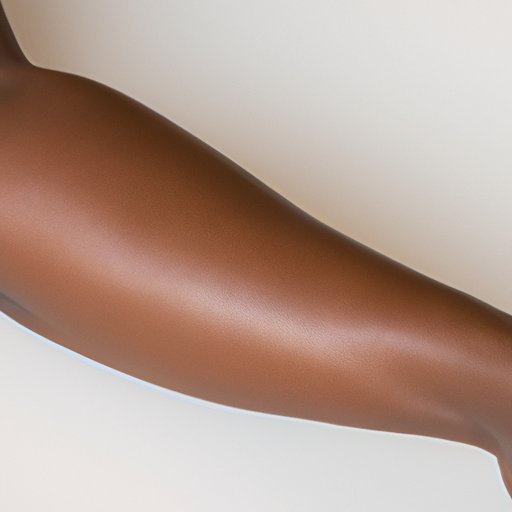
Introduction
Stretch marks are a common concern for many people, especially those who have experienced changes in their weight. While stretch marks are often associated with pregnancy, they can also happen to both men and women who experience sudden or significant weight loss. In this article, we will explore the relationship between stretch marks and weight loss, offer practical tips to minimize their appearance, and encourage self-acceptance and a holistic approach to weight loss.
The Science Behind Stretch Marks and Weight Loss
Stretch marks are caused by the stretching of skin, which can occur when the skin is suddenly stretched due to rapid weight gain or loss. While the skin is designed to stretch and accommodate such changes, sudden weight fluctuations can cause the collagen and elastin fibers that give the skin its elasticity to break down and produce scars, known as stretch marks. During the weight loss process, the skin tries to adjust to a new shape by shrinking, and when the skin loses its elasticity, stretch marks can develop.
The appearance of stretch marks is also influenced by genetics, age, and skin type. People with fairer skin tend to develop more visible stretch marks than those with darker complexions. Similarly, older individuals may experience more difficulty in skin elasticity, making them more prone to stretch marks.
Practical Tips to Minimize Stretch Marks after Weight Loss
While there is no guaranteed way to prevent stretch marks altogether, there are several ways to minimize their appearance. One of the most critical things is to maintain skin health with a healthy and balanced diet rich in essential vitamins and minerals that promote good skin health. Vitamin C in fruits and vegetables, for example, has been found to help retain skin elasticity, while vitamin E in nuts and seeds has been found to reduce the appearance of scars and stretch marks.
Staying hydrated by drinking plenty of water and avoiding excessive sun exposure can also help maintain skin health. Using moisturizers and lotions that contain ingredients like cocoa butter, shea butter, and olive oil can help nourish and protect the skin. Also, remember to protect your skin from the sun with sunscreen and protective clothing, as excessive exposure to the sun’s harmful rays can dry out the skin and reduce its elasticity.
If you already have stretch marks, you can try using various topical treatments such as creams, gels, and oils that contain retinoids, hyaluronic acid, or glycolic acid. These ingredients can help boost collagen production and reduce the appearance of stretch marks. However, these treatments might not work for everyone, and consulting a dermatologist would be the best option.
Real-Life Experiences of Individuals Who Have Lost Weight and Developed Stretch Marks
To better understand the impact of stretch marks on people who have experienced significant weight loss, we interviewed a few individuals who have gone through the process.
Jane, a 35-year-old mother who lost over 60 pounds, said that she struggled with accepting the changes in her body. She initially felt self-conscious about the stretch marks on her stomach, but she learned to embrace them as a sign of her journey and progress.
Similarly, David, a 45-year-old man who lost over 100 pounds, said that he was initially embarrassed by his stretch marks. Still, he found comfort in talking about his journey with others who had similar experiences. “I know that many people go through the same thing, and it’s just a part of my body, it tells a story,” he shared.
Listening to other people’s stories, experiences, and insights can help those who experience stretch marks better navigate their feelings and learn to embrace their bodies.
Common Misconceptions about Stretch Marks and Weight Loss
One of the most common misconceptions about stretch marks is that they only occur during pregnancy. As we have seen, they are common in people who have experienced sudden or significant weight loss, as well as those who have gained muscle mass through bodybuilding or other fitness activities.
Another common myth is that stretch marks are entirely preventable. While maintaining a healthy lifestyle and using topical treatments can help reduce their appearance, the development of stretch marks is often influenced by genetics and other factors beyond our control like age and skin type.
Open a Dialogue about Self-Acceptance and Body Positivity
It’s essential to embrace self-love and body positivity throughout the weight loss journey, recognizing that stretch marks are a natural part of the process. Instead of focusing on flaws or perceived imperfections, embrace changes as a testament to your progress and journey towards a healthier lifestyle.
By engaging in positive self-talk, supporting and surrounding yourself with people who lift your spirits, and celebrating milestones and successes, you can create a healthy and supportive environment that promotes self-acceptance and body positivity.
Promote a Holistic Approach to Weight Loss
Lastly, it’s essential to take a holistic approach to weight loss that focuses on maintaining a balanced and healthy lifestyle. This includes regular exercise, a balanced diet rich in essential nutrients, adequate sleep, stress management, and self-care.
Living a healthy lifestyle can help mitigate the risk of developing stretch marks while also promoting good overall health and well-being. And remember, the journey towards a healthy lifestyle is a marathon, not a sprint, so be kind to yourself and embrace every part of your journey, including stretch marks.
Conclusion
In conclusion, stretch marks are not unusual during weight loss, but there are several practical tips and approaches to minimize their appearance and promote overall skin health. By embracing self-acceptance, body positivity, and a holistic approach to weight loss, you can chart a path towards overall well-being and progress.
Remember, stretch marks are a part of our journey, and ultimately, what matters most is how we feel about ourselves, not how we look.





